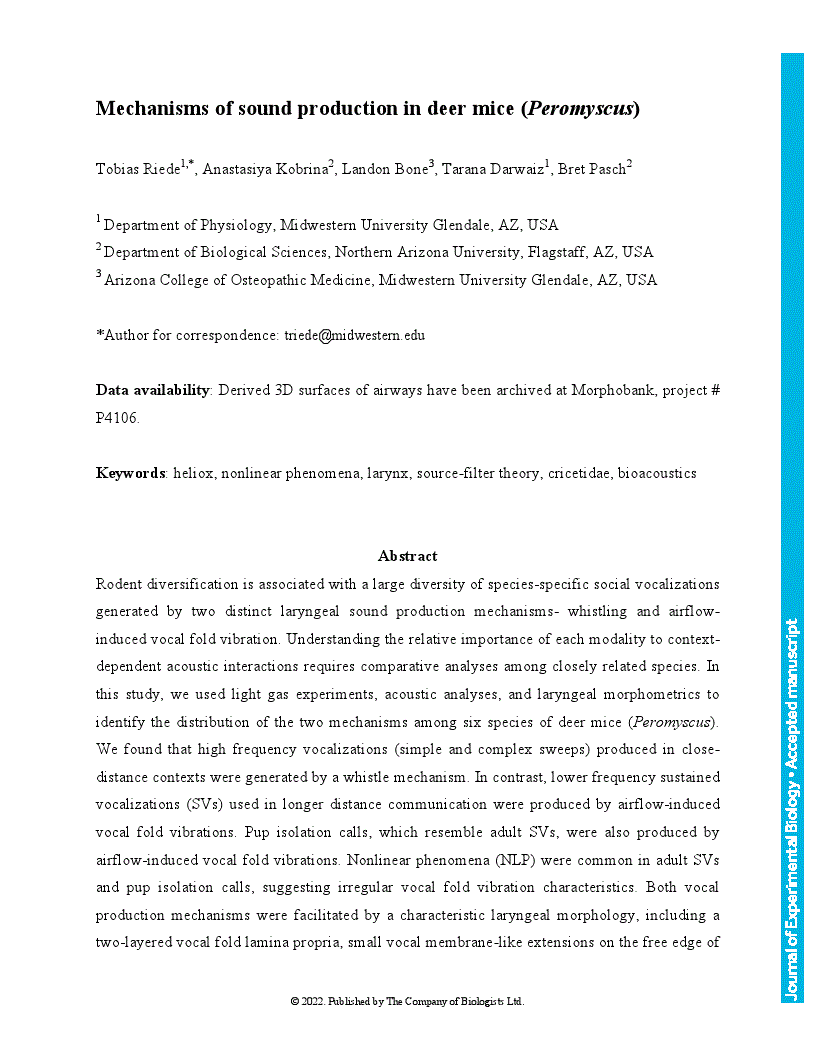Rodent diversification is associated with a large diversity of species-specific social vocalizations generated by two distinct laryngeal sound production mechanisms- whistling and airflow-induced vocal fold vibration. Understanding the relative importance of each modality to context-dependent acoustic interactions requires comparative analyses among closely related species. In this study, we used light gas experiments, acoustic analyses, and laryngeal morphometrics to identify the distribution of the two mechanisms among six species of deer mice (Peromyscus). We found that high frequency vocalizations (simple and complex sweeps) produced in close-distance contexts were generated by a whistle mechanism. In contrast, lower frequency sustained vocalizations (SVs) used in longer distance communication were produced by airflow-induced vocal fold vibrations. Pup isolation calls, which resemble adult SVs, were also produced by airflow-induced vocal fold vibrations. Nonlinear phenomena (NLP) were common in adult SVs and pup isolation calls, suggesting irregular vocal fold vibration characteristics. Both vocal production mechanisms were facilitated by a characteristic laryngeal morphology, including a two-layered vocal fold lamina propria, small vocal membrane-like extensions on the free edge of the vocal fold, and a singular ventral laryngeal air pocket known as the ventral pouch. The size and composition of vocal folds (rather than total laryngeal size) appears to contribute to species-specific acoustic properties. Our findings suggest that dual modes of sound production are more widespread among rodents than previously appreciated. Additionally, the common occurrence of NLP highlight the nonlinearity of the vocal apparatus, whereby small changes in anatomy or physiological control trigger large changes in behavioral output. Finally, consistency in mechanisms of sound production used by neonates and adults underscores the importance of considering vocal ontogeny in the diversification of species-specific acoustic signals.
Mechanisms of sound production in deer mice (Peromyscus)
- Award Group:
- Funder(s): National Science Foundation
- Award Id(s): IOS # 1754332
- Funder(s):
- Award Group:
- Funder(s): National Institutes of Health
- Award Id(s): 5R01DC018280-02
- Funder(s):
Currently Viewing Accepted Manuscript - Newer Version Available
- Split-screen
- Views Icon Views
- Open the PDF for in another window
-
Article Versions Icon
Versions
- Version of Record 12 May 2022
- Accepted Manuscript 12 April 2022
- Share Icon Share
-
Tools Icon
Tools
- Search Site
Tobias Riede, Anastasiya Kobrina, Landon Bone, Tarana Darwaiz, Bret Pasch; Mechanisms of sound production in deer mice (Peromyscus). J Exp Biol 2022; jeb.243695. doi: https://doi.org/10.1242/jeb.243695
Download citation file:
Advertisement
2023 JEB Outstanding Paper Prize shortlist and winner

The JEB Editors are delighted to announce the shortlisted authors for the 2023 JEB Outstanding Paper Prize. Read the winning paper - Tiny spies: mosquito antennae are sensitive sensors for eavesdropping on frog calls - by Hoover Pantoja-Sanchez and Brian Leavell from Ximena Bernal's lab at Purdue University, USA.
JEB Science Communication Workshop for ECRs

If you’re an early-career researcher interested in science communication and are attending the SEB Annual Conference in Prague this summer, come a day early and join the JEB Editors at a sci comm workshop to learn the key writing skills needed to promote your research to a broad audience beyond your peers (1 July at 14.30-17.30). Places are limited to 24 attendees, and applicants should apply through the SEB registration page by 30 April 2024.
Bridging the gap between controlled conditions and natural habitats in understanding behaviour

Novel technologies enable behavioural experiments with non-model species, in naturalistic habitats and with underexplored behaviours. In their Commentary, Scholz and colleagues discuss how to obtain a deeper understanding of the natural ecology and lifestyle of study animals.
Beluga metabolic measures could help save species

To help save animals from extinction, it’s important to understand what each species needs to survive. This led Jason John et al. to measure the metabolic rates of captive belugas to develop a ‘fish calculator’ showing that the whales need to eat ~23 salmon per day.
ECR Workshop on Positive Peer Review

Are you an ECR looking for tips on how to write concise, astute and useful manuscript reviews? If so, join the JEB Editors at a 2-hour JEB-sponsored Workshop on Positive Peer Review at the Canadian Society of Zoologists annual meeting in Moncton on 9 May 2024 at 13.00-15.00. There are 25 spaces for ECRs and selection is first come, first serve. To sign up, check the ECR Workshop box when you register for the CSZ meeting.



